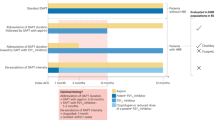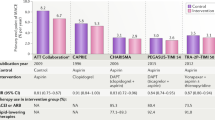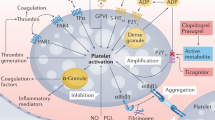Abstract
Antiplatelet therapy with aspirin and clopidogrel is standard care following revascularization by percutaneous coronary intervention with stent insertion. This so-called dual therapy is recommended for up to 4 weeks after intervention for bare-metal stents and for 6–12 months after intervention for drug-eluting stents. Although it is estimated that 5% of patients undergoing percutaneous coronary intervention require long-term anticoagulation because of an underlying chronic medical condition, continuing treatment with triple therapy (warfarin, aspirin and clopidogrel) increases the risk of bleeding. In most patients triple antithrombotic therapy seems justified for a short period of time. In some patients, however, a more considered judgment based on absolute need for triple therapy, risk of bleeding and risk of stent thrombosis is required, but the optimum antithrombotic treatment for these patients who require long-term anticoagulation has not been defined. This Review summarizes the existing literature concerning antithrombotic therapy and makes recommendations for initiation and duration of triple therapy in the small proportion of patients already receiving anticoagulant therapy who require percutaneous coronary intervention.
Key Points
-
An estimated 5% of patients requiring percutaneous revascularization require long-term anticoagulation therapy
-
As the optimum antiplatelet therapy duration is not known, a balance has to be made between the risks of thromboembolism, bleeding and stent thrombosis
-
Only limited and circumstantial evidence is available for best antithrombotic practice after percutaneous coronary revascularization in patients who require long-term oral anticoagulation, and thus determining the type and duration of antithrombotic therapy needs to be made on an individual basis
-
Coronary lesions should be carefully evaluated before revascularization
-
Bare-metal stents, requiring reduced antiplatelet therapy duration, should be considered in patients requiring long-term anticoagulation therapy
This is a preview of subscription content, access via your institution
Access options
Subscribe to this journal
Receive 12 print issues and online access
$209.00 per year
only $17.42 per issue
Buy this article
- Purchase on Springer Link
- Instant access to full article PDF
Prices may be subject to local taxes which are calculated during checkout
Similar content being viewed by others
References
Barnathan E et al. (1987) Aspirin and dipyridamole in the prevention of acute coronary thrombosis complicating coronary angioplasty. Circulation 76: 125–134
Schwartz L et al. (1988) Aspirin and dipyridamole in the prevention of restenosis after percutaneous transluminal coronary angioplasty. N Eng J Med 318: 1714–1719
Serruys PW et al. (1994) A comparison of balloon-expandable stent implantation with balloon angioplasty in patients with coronary artery disease. N Eng J Med 331: 489–495
Schror K (1998) Clinical pharmacology of the adenosine diphosphate (ADP) receptor antagonist, clopidogrel. Vasc Med 3: 247–251
Hall P et al. (1996) A randomized comparison of combined ticlopidine and aspirin therapy versus aspirin therapy alone after successful intravascular ultrasound-guided stent implantation. Circulation 93: 215–222
Urban P et al. (1998) Randomized evaluation of anticoagulation versus antiplatelet therapy after coronary stent implantation in high-risk patients: the Multicenter Aspirin and Ticlopidine Trial after Intracoronary Stenting (MATTIS). Circulation 98: 2126–2132
Schömig A et al. (1996). A randomized comparison of antiplatelet and anticoagulant therapy after the placement of coronary-artery stents. N Engl J Med 334: 1084–1089
Leon MB et al. (1998) A clinical trial comparing three antithrombotic-drug regimens after coronary-artery stenting. N Engl J Med 339: 1665–1671
Bertrand ME et al. (1998) Randomized multicenter comparison of conventional anticoagulation versus antiplatelet therapy in unplanned and elective coronary stenting: the full anticoagulation versus aspirin and ticlopidine (FANTASTIC) study. Circulation 98: 1597–1603
Silber S et al. (2005) Guidelines for percutaneous coronary interventions. The Task Force for Percutaneous Coronary Interventions of the European Society of Cardiology. Eur Heart J 26: 804–847
Popma JJ et al. (2004) Antithrombotic therapy during percutaneous coronary intervention: the seventh ACCP conference on antithrombotic and thrombolytic therapy. Chest 126 (Suppl 3): S576–S599
Spencer FA et al. (2004) When guidelines collide. Am Heart J 147: 395–397
Rubboli A et al. (2004) Antithrombotic treatment after coronary artery stenting in patients on chronic oral anticoagulation: an international survey of current clinical practice. Ital Heart J 5: 851–856
Rubboli et al. (2005) Meta-analysis of trials comparing oral anticoagulation and aspirin versus dual antiplatelet therapy after coronary stenting. Cardiology 104: 101–106
Lagerstedt CI et al. (1985) Need for long-term anticoagulant treatment in symptomatic calf-vein thrombosis. Lancet 2: 515–518
Büller et al. (2004) Antithrombotic therapy for venous thromboembolic disease: the Seventh ACCP Conference on antithrombotic and thrombolytic therapy. Chest 126 (Suppl 3): S401–S428
Kearon C et al. (2001) Comparison of low-intensity warfarin therapy with conventional-intensity warfarin therapy for long term prevention of recurrent venous thromboembolism. N Eng J Med 349: 631–639
Kearon C et al. (2003) A comparison of three months of anticoagulation with extended anticoagulation for a first episode of idiopathic venous thromboembolism. N Eng J Med 340: 901–907
Agnelli G et al. (2001) Three months versus one year of oral anticoagulant therapy for idiopathic deep vein thrombosis. N Eng J Med 345: 165–169
Singer DE et al. (2004) Antithrombotic therapy in atrial fibrillation the Seventh ACCP Conference on antithrombotic and thrombolytic therapy. Chest 126 (Suppl 3): S429–S456
Stroke Prevention in Atrial fibrillation Investigators (1992) Predictors of thromboembolism in atrial fibrillation–I: clinical features of patients at risk. Ann Intern Med 116: 1–5
Gage BF et al. (2001) Validation of clinical classification schemes for predicting stroke: results from the national registry of atrial fibrillation. JAMA 285: 2864–2870
Aguilar M and Hart R (2005) Antiplatelet therapy for preventing stroke in patients with non-valvular atrial fibrillation and no previous history of stroke or transient ischemic attacks. The Cochrane Database of Systematic Reviews, Issue 4, Art. No CD001925
ACTIVE Writing Group on behalf of the ACTIVE Investigators; Connolly S et al. (2006) Clopidogrel plus aspirin versus oral anticoagulation for atrial fibrillation in the Atrial fibrillation Clopidogrel Trial with Irbesartan for prevention of Vascular Events (ACTIVE W): a randomised controlled trial. Lancet 367: 1903–1912
Schlitt A et al. (2003) Clopidogrel and aspirin in the prevention of thromboembolic complications after mechanical aortic valve replacement (CAPTA). Thromb Res 109: 131–135
Kearon C and Hirsh J (1997) Management of anticoagulation before and after elective surgery. N Engl J Med 336: 1506–1511
Lincoff AM et al. (2003) Bivalirudin and provisional glycoprotein IIb/IIIa blockade compared with heparin and planned glycoprotein IIb/IIIa during percutaneous coronary intervention: REPLACE-2 randomized trial. JAMA 289: 853–863
Rothman MT (2005) Drug insight: bleeding after percutaneous coronary intervention—risks, measures and impact of anticoagulant treatment options. Nat Clin Pract Cardiovasc Med 2: 465–474
Louvard Y et al. (2004) Comparison of transradial and transfemoral approaches for coronary angioplasty in octogenarians (the OCTOPUS study). Am J Cardiol 94: 1117–1180
Orford JL et al. (2004) Safety and efficacy of aspirin, clopidogrel, and warfarin after coronary stent placement in patients with an indication for anticoagulation. Am Heart J 147: 463–467
Batchelor WB et al. (2001) A randomized, placebo-controlled trial of enoxaparin after high-risk coronary stenting: the ATLAST trial. J Am Coll Cardiol 38: 1608–1613
Landefeld CS and Goldman L (1989) Major bleeding in outpatients treated with warfarin: incidence and prediction by factors known at the start of outpatient therapy. Am J Med 87: 142–152
Iakovou et al. (2005) Incidence, predictors, and outcome of thrombosis after successful implantation of drug-eluting stents. JAMA 293: 2126–2130
Moreno et al. (2005) Drug-eluting stent thrombosis: results from a pooled analysis including ten randomized studies. J Am Coll Cardiol 45: 954–959
National Institute for Health and Clinical Excellence (online 22 October 2003) 2003/053 NICE issues updated guidance on the use of coronary artery stents for the treatment of coronary artery disease [http://www.nice.org.uk/page.aspx?o=90550] (accessed 26 September 2006)
Al Suwaidi J et al. (2004) Impact of coronary stents on mortality and nonfatal myocardial infarction: meta-analysis of randomized trials comparing a strategy of routine stenting with that of balloon angioplasty. Am Heart J 147: 815–822
Douketis et al. (2004) Low-molecular-weight heparin as bridging anticoagulation during interruption of warfarin: assessment of a standardized periprocedural anticoagulation regimen. Arch Intern Med 164: 1319–1326
Kovacs MJ et al. (2004) Single-arm study of bridging therapy with low-molecular-weight heparin for patients at risk of arterial embolism who require temporary interruption of warfarin. Circulation 100: 1658–1663
ten Berg et al. (2000) Effect of coumarins started before coronary angioplasty on acute complications and long-term follow-up: a randomized trial. Circulation 102: 386–391
Hirsh et al. (2001) Oral anticoagulants: mechanism of action, clinical effectiveness, and optimal therapeutic range. Chest 119 (Suppl): S8–S21
Horstkotte D et al. (1998) Optimal frequency of patient monitoring and intensity of oral anticoagulation therapy in valvular heart disease. J Thromb Thrombolysis 5 (Suppl 1): S19–S24
Peters RJ et al. (2003) Clopidogrel in Unstable angina to prevent Recurrent Events (CURE) Trial Investigators. Effects of aspirin dose when used alone or in combination with clopidogrel in patients with acute coronary syndromes: observations from the Clopidogrel in Unstable angina to prevent Recurrent Events (CURE) study. Circulation 108: 1682–1687
Eriksson P (2004) Long term clopidogrel therapy after PTCA in PCI-CURE and CREDO: the emperor's new clothes revisited. Eur Heart J 25: 720–722
Brouwer MA and Verheught FW (2002) Oral anticoagulation for acute coronary syndromes. Circulation 105: 1270–1274
Anand SS and Yusuf S (2003) Oral anticoagulation in patients with coronary artery disease. J Am Coll Cardiol 41 (Suppl S): S62–S69
Author information
Authors and Affiliations
Corresponding author
Ethics declarations
Competing interests
The authors declare no competing financial interests.
Rights and permissions
About this article
Cite this article
Helft, G., Gilard, M., Le Feuvre, C. et al. Drug Insight: antithrombotic therapy after percutaneous coronary intervention in patients with an indication for anticoagulation. Nat Rev Cardiol 3, 673–680 (2006). https://doi.org/10.1038/ncpcardio0712
Received:
Accepted:
Issue Date:
DOI: https://doi.org/10.1038/ncpcardio0712
This article is cited by
-
A novel indication of platonin, a therapeutic immunomodulating medicine, on neuroprotection against ischemic stroke in mice
Scientific Reports (2017)
-
Drug-eluting Stents
Der Chirurg (2009)
-
Antithrombotische Therapie nach perkutaner Koronarintervention mit Stentimplantation bei Patienten ohne und mit Indikation zur oralen Antikoagulation
Der Kardiologe (2008)



